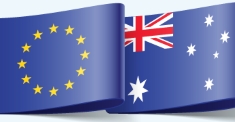EUR/AUD Trading
The EUR/AUD pair represents under 1% of all Forex transactions, and is a minor or cross pair. This currency pairing is most impacted by any change in the price of gold, as Australia is the third biggest world gold producer. Therefore, if the price of gold declines, the value of the AUD will decrease. The Australian Dollar is also strongly positively correlated to the New Zealand Dollar due to New Zealand being the nation’s favourite trading partner, due to the proximity of the two countries. If the economy of Australia is functioning healthily, New Zealand’s imports to Australia increase, having a beneficial impact upon Australia’s economic growth. The Euro’s role in the evolution of this currency pair is less prominent; however, any economic data release within the Eurozone has a clear impact upon the EUR/AUD pairing. The EUR/AUD pair is always quoted to four decimal places, although some brokers quote with five. The floating exchange rate is subject to supply and demand on the Forex market. Both the Australian Central Bank and European Central Bank intervene only rarely to change the price of this pairing. However, any decision taken by either of the two central banks will impact strongly upon the currencies.
| Broker | Bonus | More |
|---|
The Eurozone Economy and the EUR
The Euro first came into being in 2002 as the single currency for 11 EU nations (more about the Euro here). Over time, other countries have also chosen to adopt the Euro, increasing the current total of countries within the Eurozone to 16. The Euro is the second most frequently traded currency on the foreign exchange market, representing around 40% of all transactions per year. 
- Austria, Cyprus, Belgium, France, Finland, Greece, Germany, Luxembourg, Italy, Ireland, The Netherlands, Malta, Slovakia, Portugal, Slovenia and Spain.
As may be expected with such a relatively new currency, there are occasional disagreements between the governments of countries within the EU about the future course of the union and its various monetary policies. In these situations, the Euro will generally weaken.
The Australian Dollar and the Economy of Australia
The AUD is sometimes known as the Aussie, and is the currency of Australia (more info), Cocos Islands, Christmas Island and Norfolk Island, as well as the three Pacific Island states of Nauru, Kiribati and Tuvalu. Currently the fifth most-traded currency worldwide, the Australian Dollar accounts for around 8% of daily Forex trading, only behind the US Dollar, the Euro, JPY and Pound Sterling. The reason for its popularity among traders is the relatively high interest rate within the country, and the fact that their Forex market is fairly free from intervention by the government. The Australian political system is pretty stable, as is their economy, and this makes the AUD an excellent choice for any investor wishing to diversify their Forex portfolio. The AUD also has a larger amount of exposure to Asian economies.
The Australian Dollar appeared on the world market during 1966 with an interest rate that was originally pegged to the Pound Sterling. However in 1983 it changed its status to a floating currency, and this has remained the case until this day. The Australian economy is resilient and strong, being dominated primarily by the service industry, which comprises around 70% of the country’s total GDP. Australia’s agricultural and mining industries also have a key role to play, accounting for about 12% of GDP. Australia exports the majority of its products to the East Asian market, with its main commodity exports being gold, crude oil, coal, natural gas and iron ore.
What are the Benefits of Trading a Minor Pair?
When traders begin their first exploration into the Forex market, they tend to prefer trading US Dollar currency pairs. However, although there are many benefits of trading US Dollar major pairs, there are also plenty of advantages to opting for a minor or cross pairing. A major pair consists of any G8 currency paired with the US Dollar, such as EUR/USD or GBP/USD. A cross or minor pair represents a currency pair not including the USD, such as the EUR/AUD pairing. Cross pairs have been specifically developed to make the process of exchanging currencies simpler and cheaper, by eliminating the need to convert a transaction into US Dollars first before trading. When trading cross pairs, an investor is able to buy or sell the weakest and strongest currency pairs on the Forex market, allowing them to maximise their profit. This is an excellent opportunity for any trend trader, and allows them to participate in the larger market moves. Cross pairs also have greater volatility, allowing scalpers and day traders to take advantage of different trading strategies to achieve larger returns. When opting to trade the EUR/AUD pairing, investors can take advantage of both of these factors in order to have the best possible chance of profiting from their transactions.


